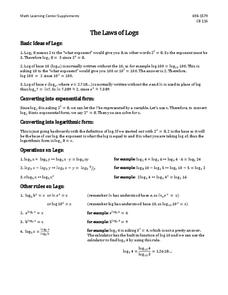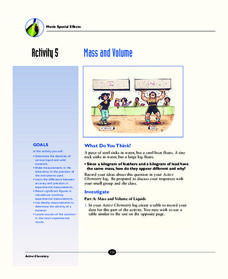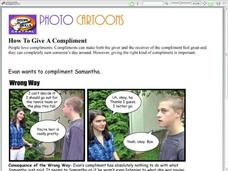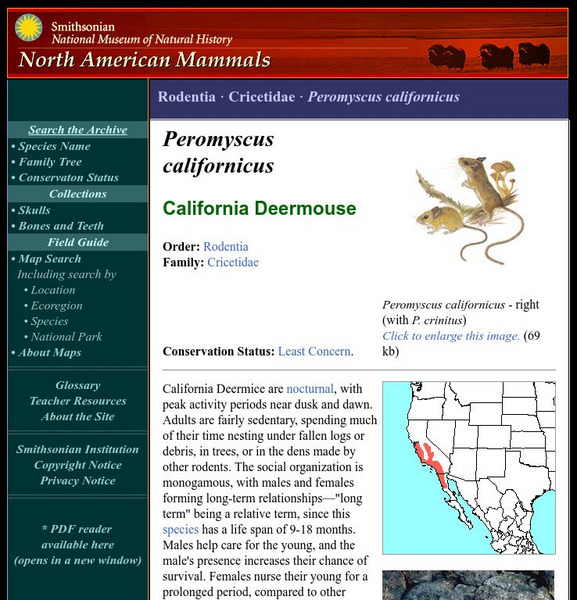Del Mar College
The Laws of Logs
Two students were sitting on a log and decided they wanted to be awesome at math. Bring in the logarithm handout! The first page introduces the idea of a logarithm and the different operations and rules it entails. The second page...
It's About Time
Circular Motion
Lead your class in this exciting activity to learn more about motion and its importance. Pupils learn about a centripetal and why it is required to maintain a constant speed in a circulating moving mass. They apply the equation for...
It's About Time
Factors Affecting Population Size
How do we predict future population growth? Young researchers investigate various factors affecting the size of our population. As they calculate and interpret graphs to determine factors that could potentially affect increases...
It's About Time
Building a Motor/Generator Toy
Combine science and playtime with the final lesson in an innovative unit. Scholars apply everything they have learned in previous lessons to build their own motors/generators and use it in a toy of their own design.
It's About Time
Elements and Compounds
Young scientists use electrolysis to separate water into its elements before experimenting with fire to learn about their properties. A helpful resource provides a reading passage and analysis questions.
It's About Time
Reflected Light
The lesson allows young scientists to use lasers and mirrors to study reflected light. A reading passage and homework question assess learning, while additional material introduces extension activities.
Curated OER
Using Google Docs
This is a fantastic resource for teachers to have in their tool belts upon entering into the world of using Google Docs in the classroom! It is a reference sheet with step-by-step instructions and graphics for everything from basic...
It's About Time
Concentrating on Collisions
How important is momentum? Pupils investigate and apply the definition of momentum as they conduct analyses during a series of one-dimensional collisions. They infer the relative masses of two objects by carefully staging and predicting...
It's About Time
Succession in Communities
What occurs following a natural disaster? High schoolers research this question and others as they investigate natural succession after a disaster. First, as they differentiate between primary and secondary succession, they explain...
Curated OER
The Language of Love
In this language arts worksheet, students learn that there are many ways to express love using words. Students read 20 sentences which show different ways of expressing affection. Example: "You are in my heart." There are no questions...
Shoreline Community College
Properties of Logarithmic Functions
Use a straightforward approach to understanding logarithmic properties and their role in solving exponential and logarithmic equations to your math class. The lesson begins with an overview of a logarithmic function and its...
Everett Public Schools
High School Writing: Student Guide
Here's an amazing writing guide that deserves a place in your curriculum library. The 136-page packet provides focus lessons on the writing process, expository, persuasive, and timed writing, the Cornell system of note taking, and...
abcteach
Metric Conversions Cheat Sheet
How do you convert inches to centimeters? Or pints to liters? This handy reference guide has both US to metric, and metric to US conversions in a quick, easy-to-read format. Mass, area, volume, capacity, and length conversions are...
It's About Time
Mass and Volume
Don't be so dense that light bends around you; study the relationship between mass and volume instead. Young chemists measure the density of a variety of liquids and solids. A reading passage and analysis questions introduce pupils to...
It's About Time
Organic Substances
Host an exciting lab in which learners burn fruit rinds to better understand hydrocarbons. A reading passage and analysis questions wrap up the lesson.
It's About Time
Metals and Nonmetals
Did you know you can melt the metal gallium with just the heat of your hand? Pupils observe and test materials in order to classify them as metal or non-metal. A reading passage and analysis questions wrap up the lesson.
Social Skills Central
Photo Cartoons: How To Give A Compliment
Help learners develop the ability to offer appropriate, meaningful compliments to others—an essential social skill. Here you'll find a quick photo cartoon illustrating a right and wrong way to give a compliment, as well as a brief...
It's About Time
Photosynthesis, Respiration, and the Carbon Cycle
Provide your class with the opportunity to view our carbon cycle close up. Young scientists research the cycle of oxygen as it completes the tasks of photosynthesis and respiration. They explore the importance of carbon in an ecosystem...
Bagheera
Bagheera: Tropical Rain Forests
This site explores the value and diversity of tropical rain forests. Learn about the rate of decline of these natural wonders, the causes of deforestation, and more.
Wonderville Media
Wonderville: Abraham Lincoln
Abraham Lincoln grew up in a small, one-room log cabin in Kentucky. He was the son of two farmers who were illiterate, which means they did not know how to read. He had a brother and a sister who both died when they were babies. Learn...
Other
Stat Soft: Statistics Glossary
Dozens of statistical terms are defined and illustrated in this glossary.
Smithsonian Institution
National Museum of Natural History: American Mammals: Townsend's Chipmunk
Clear-cut logging, which destroys habitat for some animals, offers good living conditions for Townsend's chipmunks. They find denning sites, cover, and food among the fallen, decaying logs and sprouting evergreens. Learn more about the...
Smithsonian Institution
National Museum of Natural History: American Mammals: California Deermouse
California Deermice are nocturnal, with peak activity periods near dusk and dawn. Adults are fairly sedentary, spending much of their time nesting under fallen logs or debris, in trees, or in the dens made by other rodents. Learn more...
Smithsonian Institution
National Museum of Natural History: American Mammals: Pacific Shrew
An inhabitant of Oregon's moist streamsides, thickets, and woods, the Pacific Shrew does best in areas with brushy vegetation and fallen decaying logs. There it finds centipedes, slugs, and snails, insect larvae, amphibians, fungi, and...
Other popular searches
- Holes" Learning Log
- Holes Learning Log
- Math Learning Logs
- Learning Logs for Math
- Learning Logos
- Learning Logs Strategy
- Learning Logs for Jazz
- Social Studies Learning Logs






















